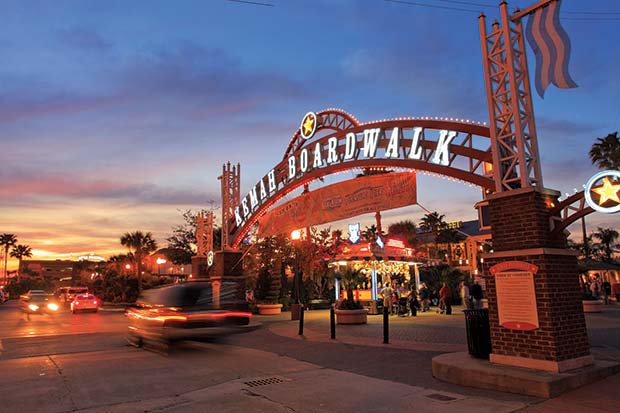
Kemah Boardwalk. Photo by Eric W. Pohl
We love the night illuminated, whether by the strobe of fireflies or the dazzle of Ferris wheels, and we are drawn to light’s embrace whenever it glimmers in the darkness like an invitation to dance. We may not be much good at the moves, but it beats standing alone in a dark corner tapping our feet.
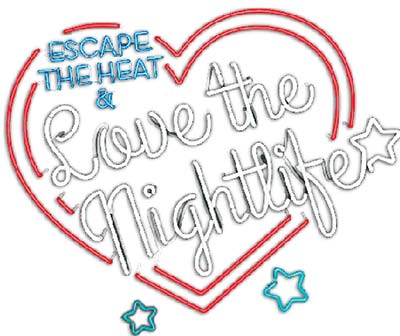 “I love the nightlife” is an apt maxim for a spectrum of activities that might begin, at least for me, with a moonlit mountain bike ride along the beach and culminate with a rowdy ZZ Top concert at Corpus Christi’s outdoor Concrete Street Amphitheater. (Like disco queen Alicia Bridges, I got to boogie.) And since night comprises about 50 percent of our routine cycle with sleep dominating only a quarter of the total 24 hours, we’re left with a considerable number of hours for entertainment after dark. Following are a dozen suggestions for making the most of the Texas nightlife, a few of them annual events and others that you may have never considered before. Give them a try—they’re guaranteed to light up your night.
“I love the nightlife” is an apt maxim for a spectrum of activities that might begin, at least for me, with a moonlit mountain bike ride along the beach and culminate with a rowdy ZZ Top concert at Corpus Christi’s outdoor Concrete Street Amphitheater. (Like disco queen Alicia Bridges, I got to boogie.) And since night comprises about 50 percent of our routine cycle with sleep dominating only a quarter of the total 24 hours, we’re left with a considerable number of hours for entertainment after dark. Following are a dozen suggestions for making the most of the Texas nightlife, a few of them annual events and others that you may have never considered before. Give them a try—they’re guaranteed to light up your night.
Tilt Your World
Nothing lights up the night sky with more energy than an amusement park peaking at its electrified zenith, all flashing bulbs and pulsing neon with coasters rolling, teacups spinning, space shots dropping, and whirls a-tilting. Its soundtrack, a din of whoops and screams, calliope loops, and steel wheels sparking steel rails, magnifies the park’s overriding scent of singed sugar mixed with ozone, elevating the evening’s fare like plot twists driving your own personal movie to its ultimate climax. Thrills or chills? If you’re lucky you’ll get a lot of both.
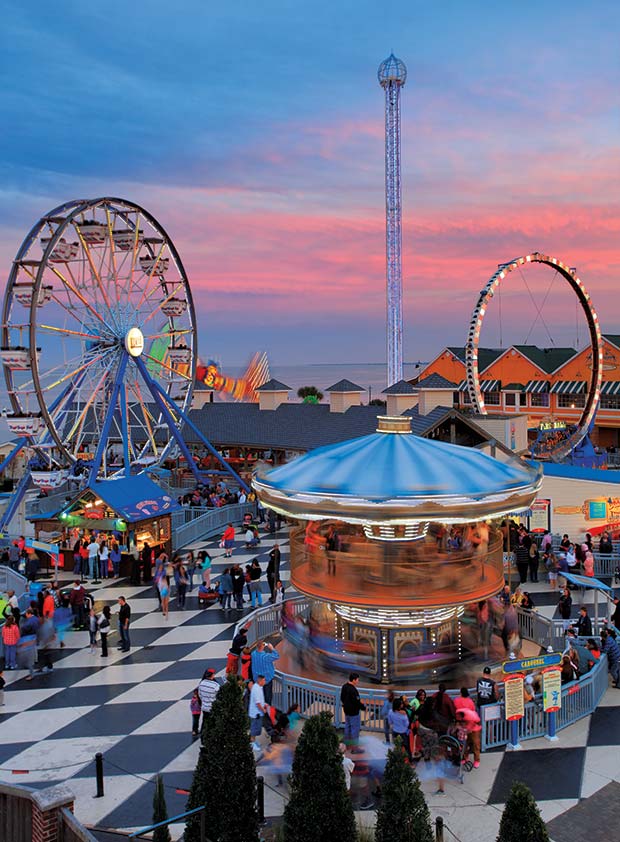
Kemah Boardwalk. Photo by Eric W. Pohl
Many of the state’s best amusement parks operate well into the evening, giving you ample opportunity to create a moment to remember. The state’s biggest parks are great places to start- Six Flags Over Texas in Arlington and Six Flags Fiesta Texas in San Antonio stay open later as the summer progresses. The Pleasure Pier in Galveston, open until 11 p.m most days during the summer months, offers the Iron Shark Rollercoaster, fried shrimp, and warm Gulf breezes.
Another coastal amusement park, the Kemah Boardwalk, located 20 minutes from downtown Houston, features a dozen restaurants, the Boardwalk Bullet (with 42 track crossovers, a record for a wooden rollercoaster), late operating hours during the summer, and nighttime special events, such as a Zombie Night Party on October 19.
Swing, Batter!
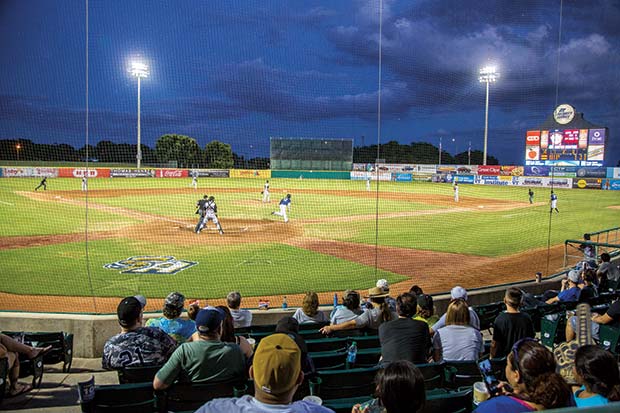
San Antonio Missions at Nelson Wolff Municipal Stadium. Photo by Will van Overbeek.
Unlike basketball and football, in which body slams, fouls, and the frantic hustle between goals dominate the field, baseball is an egalitarian sport. Equitably spaced and systematically played, a baseball game conjures a tranquil world in which the scent of bratwurst and beer wafts in a cool summer breeze and bleacher balls win rousing applause.
As dusk turns to dark, ballpark lights flood the field and illuminate the green lawn striping and its ephemeral chalk-white dusting. And, hey, is that a giant tumbling coyote? No, it’s the home-team mascot trying to cartwheel down the field but his bulbous nose gets in the way and he stumbles! Is he injured? Not too badly! He limps over to the T-shirt cannon to launch shirts into the crowd! YES!
Texas’ two big league teams, the Houston Astros and the Texas Rangers, play regular season games through September. The Astros play in enclosed Minute Maid Park and occasionally open the retractable roof on cool nights; the Rangers compete al fresco in Arlington’s Globe Life Park, making night games particularly pleasant. Minor league and independent teams across the state also play in outdoor stadiums with most of their seasons running through the summer. From El Paso (the Chihuahuas) to Sugar Land (the Skeeters), nighttime is the right time to play ball.
Seeking Big Foot
Just exactly what (or who) is Bigfoot? An undiscovered primate? An enigma? The missing link? Or just missing Uncle Harry in need of a shave? Try “wood ape,” according to the North American Wood Ape Conservancy, a Texas-based nonprofit dedicated to investigating the existence of the unlisted primate species known more commonly as “Sasquatch” or “Bigfoot.”
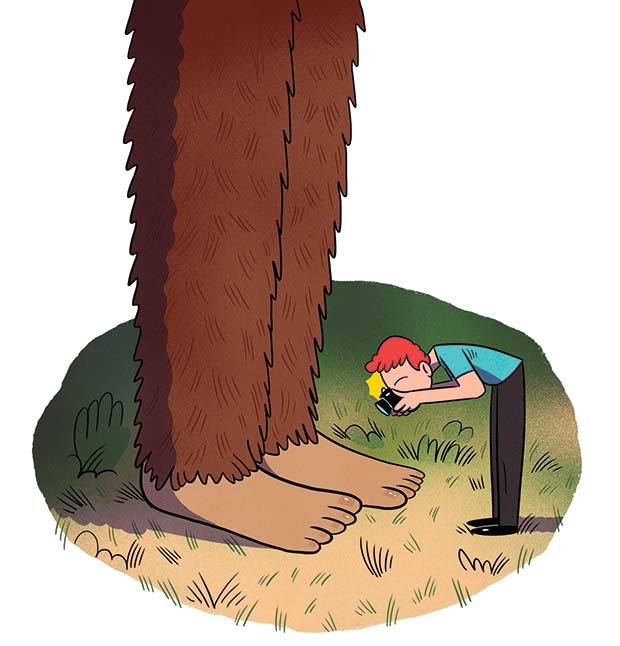
Illustration by Ryan Snook.
Bigfoot, based on the stories of North American indigenous people, received a spike in interest in the 1950s when British mountaineer Eric Shipton claimed to have discovered, at the base of Mount Everest, a footprint belonging to an Abominable Snowman, known to Tibetan and Nepalese cultures as a Yeti. Enthusiasm waxed and waned over the next few decades—including a handful of reported sightings in California and Oregon—until the rise of reality television and the advent of Animal Planet’s popular “Finding Bigfoot.”
Today, claims of wood ape sightings extend into Texas. Check out the latest reports on the Wood Ape Conservancy’s website or on their Facebook page. If you want to take a crack at solving the mystery of Bigfoot yourself, slip out one quiet evening into the woods and look for signs of the creature. Why at night? Because it’s more fun! Pick up some Bigfoot discovery tips at www.woodape.org.
Chicken on a String
Few Texans would ever turn down a day at the beach. It’s a relaxing, all-day adventure, usually peaking with a plate of sand-dusted burgers in the mid-afternoon sun. But as night takes over, the coastal environs become the realm of those who consider the beach and bays at night a playground transformed.
For instance, at Corpus Christi’s Packery Channel, you can try your hand at shrimping by shining a light on the surface and using a dip net to scoop shrimp (usually most effective during seasonal changes and turgid water conditions). Then, try threading the shrimp onto a bait hook and casting it off the Packery Channel jetties, which cater to anglers with their cement walkways and guardrails.
If you want to hover over deeper waters, try the Horace Caldwell Pier in Port Aransas. This 1,200-foot-long concrete pier offers well-lit night fishing for a variety of sizable Gulf species, including pompano, black drum, redfish, and speckled trout. Even if the fish aren’t biting, you can still grab a bite of your own at Keepers, the bait shop/restaurant on the pier.
You can also stick with the basics and catch tasty blue crabs using string, a chicken leg or neck, and a dip net. Mustang Island’s bay access points are prime spots to net crabs. At the water’s edge, find the small, deeper channels (a few feet deep will do), tie the chicken onto the string, and toss it into the water. When you feel a tug on the string, slowly draw the string, and carefully scoop up the crab with your net. If you’re not quite quick enough, head to Kody’s Restaurant in Port Aransas and order the crab-stuffed fried avocado.
Night Rider
Fairs and rodeos, like beans and cornbread, go hand-in-hand. How else would you be able to get your fill of funnel cakes, midway games, wild cow-milking contests, and bantam chickens at the same time? Fortunately, these classic Texas country events have enjoyed a century-old merger, bringing county fairs, rodeos, and carnivals together for one big entertaining night of bronco busting, pie bake-offs, and ribbon-winning pigs.
Texas rodeo history traces its roots to the Spanish Colonial era south of the border. Spaniards, arriving on present-day Mexican shores, brought the art of the roundup with them, passing the skills along to Mexican vaqueros who bequeathed them to the pre-statehood Texas frontier. Meanwhile, Texans have been congregating for regional fairs since the 19th Century, when farming was the state’s primary occupation, to show off their agricultural products, socialize with neighbors, and find entertainment.
Three of the state’s longest-running traditional regional fairs take place annually in the fall. In the Panhandle, the Amarillo Tri-State Exposition, chartered in 1923, draws more than 130,000 people for nine days of events—September 16 through 21—including rodeos, horse shows, all manner of crafts and culinary contests, and livestock demonstrations. In Waco, the Heart O’ Texas Fair and Rodeo—October 3-13—features all the trappings of a well-rounded regional fair, including a PRCA rodeo and country music concerts. In Tyler, the East Texas State Fair—September 20- 29—is a celebration of agricultural heritage with enticing extras like a carnival featuring more than 40 rides, an alligator show, and even an Academic Rodeo for local schools.
‘It’s Full of Stars!’
A view into the night sky courtesy of the McDonald Observatory, the state’s star-gazing capital located atop Mount Locke in the Davis Mountains of West Texas, usually produces a response best phrased by the protagonist of the classic 1968 sci-fi work 2001: A Space Odyssey. In the film, Dave Bowman, lone survivor of a discovery mission to Saturn, approaches the mysterious Tycho crater monolith in his space pod and exclaims “Oh my God, it’s full of stars!” just before disappearing into the infinite.
You have multiple opportunities across Texas to experience a similar sensation at stellar star parties such as the Starry Night event at the Houston Museum of Natural Science’s George Observatory at Brazos Bend State Park. On August 31, Copper Breaks State Park will host a Star Walk for visitors. Don’t forget to bring chars, blankets and binoculars!
But McDonald Observatory offers the most dramatic star gazing, especially if you sign up for one of its special viewing nights. The observatory stages several experiences beyond its weekly Star Party events, engaging attendees with a view into deeper space via one of three research telescopes. One of them, the massive 82-inch Otto Struve, is among the largest telescopes on the planet that’s accessible to the public.
As an added bonus, attendees can book an overnight at the Astronomer’s Lodge located just below the telescopes. The viewing programs run three hours or more, making an overnight at the lodge convenient and comfortable. Best yet, stepping outside on a moonless night during your stay provides a startling view of an incalculable array of stars overhead.
Golf Party
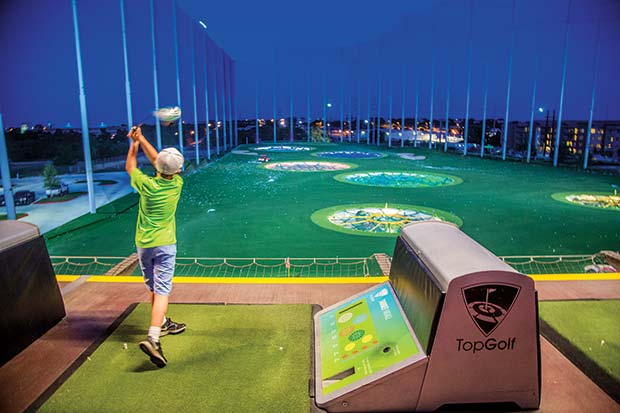
Top Golf. Photo by Will van Overbeek
In 2000, British brothers Steve and Dave Jolliffe, avid golfers who frequented their local North London driving range, became determined to solve some of golfing’s most perplexing questions. Precisely how far does the ball travel when you hit it, and where, exactly, does it land in relation to your target? Along the way, they decided to add in some fun. The result, with plenty of technical assistance, was Topgolf, acronym for “Target Oriented Practice Golf.”
Today, Topgolf International Inc., now based in Dallas, is rapidly expanding its entertainment concept with locations throughout Texas, the United States, and the United Kingdom. The Topgolf principle is simple: Hit a microchip-embedded golf ball across a 215-yard outfield at dartboard-like targets capable of detecting information and relaying it back to your score screen. Competitive and entertaining, Topgolf is designed for both the golfing enthusiast and first-time players. Even better, Topgolf facilities offer food and beverages and cater to special events and parties—and stay open until midnight or later.
With over eight locations in Texas—Allen, Austin, The Colony, El Paso, Dallas, Houston, San Antonio, Spring, Webster, Fort Worth—Topgolf may be the leisure sport of the future.
All Eyes on You
A few moonless nights ago, I drove along a rural dirt road looking for wildlife. Absent of city lights, the darkness was as dense as molasses, and as I crept along I noticed an odd shape rising above a yucca growing next to the road ahead. I slowed to a crawl, and as I passed the yucca, I locked eyes with a great horned owl just outside the passenger window. The glow of the cab lights illuminated its considerable stare, glassy and unflinching, and as I came to a full stop I felt its scrutiny, intimidating and annoyed, before it had enough of my dumbfounded gaze and flew away.
Texas nights are full of wildlife, as well as plenty of guided opportunities to spot animals after dark. The Trinity River Audubon Center, located along the river in southern Dallas, offers the Owl Prowl, an all-ages event held on occasion year-round. The class includes an educational presentation about the four local owls—Eastern screech, barn, barred, and great horned—followed by “owling” on the center’s trails, in which the class calls for owls with a smart-phone app and speaker.
In Glen Rose, Fossil Rim Wildlife Center, where the wildlife runs free, features a recurring Discovery After Dark tour. Enjoy a spotlighted adventure across the center’s terrain for an unusual look at native and exotic wildlife, such as black-tailed jackrabbits and rhinoceroses.
For a do-it-yourself summer nighttime wildlife adventure, visit Austin’s Congress Avenue Bridge at dusk and witness hundreds of thousands of Mexican free-tailed bats emerge from the bridge’s underbelly.
Light Fantastic
San Antonio is a night-lover’s town. Its historic Main Plaza and festive River Walk, featuring illuminated bridges, restaurants, shops, and clubs, are favorite destinations, renowned for their elaborate displays of lights, parades, and celebrations. Original art also abounds within the city and, in particular, night owls won’t want to miss the video art installation by French artist Xavier de Richemont. Called San Antonio, The Saga, the artwork is a 24-minute, 7,000-square-foot projection covering the facade of the historic San Fernando Cathedral located in the Main Plaza.
The Saga conveys San Antonio’s robust history with a light and sound show, transforming the cathedral’s Gothic Revival facade into a hallucinatory history lesson. Richemont, who is based in Paris, draws from his work in opera and theater to create large-scale projections like the multi-image phantasmagoria in San Antonio. Similar works by Richemont have been presented in Canada, Germany, and Mexico. Many of the projected images, designed to appear and fade sequentially, are original paintings and colorful compositions by the artist.
Presented by the Main Plaza Conservancy, the video art installation is scheduled to show through 2024. Throughout 2016, shows are at 9 p.m., 9:30 p.m., and 10 p.m. every Tuesday, Friday, Saturday, and Sunday. Attendance is free.
Wet, Dark, and Wild
Remembering the summer nights of my misspent youth, I confess to an affinity for night swims in rivers, spring-fed pools, and stock tanks—wherever the water was cool and the lights were absent. Nothing soothes the spirit more thoroughly than a dip in fresh waters at night. The calming air stills the liquid surface, smoothed flat and taut like a bed sheet, while the line between earth and sky vanishes, filling the entire void with the sparkle of star shine. The moment you dive in it feels as if you’re jumping into the infinite.
Many public pools across Texas offer special nighttime, family-friendly swimming events, but Austin’s Barton Springs Pool is the favorite of many. Located in Zilker Park, the spring-fed pool occupies approximately three acres and maintains an average temperature of around 68 degrees. Guarded and unguarded hours vary; the pool opens 5 a.m.-10 p.m. daily (5-9 a.m., 7-10 p.m. on Thursdays)
Elsewhere in the state, Lampasas offers annual moonlight swims (July 15 and 20th this year) in the historic Hancock Free Flow Swimming Pool. The moonlight events include a potluck dinner and a live band that plays until 11 p.m. The spring-fed pool, built in 1911, contains more than 300,000 gallons of clear spring water. The pool opens from June to September on Thursdays through Sundays.
Or get some evening tubing in the San Marcos River open until 8 p.m. Nearby, The Meadows Center for Water and the Environment offers stand-up paddleboard and kayak outings on Spring Lake, including sunset and full-moon tours, with gear and instruction provided by REI Outdoor School.
Bond with bowling
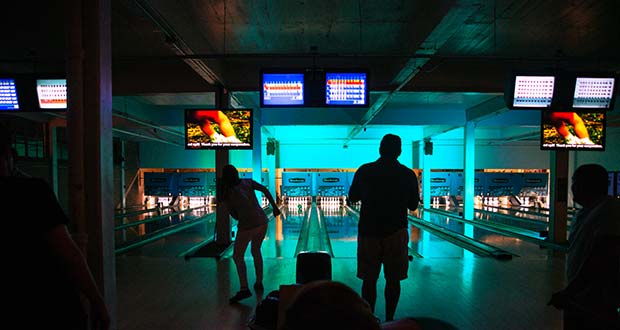
In the 1970s TV comedy “Laverne and Shirley,” two kooky Milwaukee roommates favored bowling as their favorite pastime—in service to the show as both backdrop and metaphor. Their playful Yiddish chant, “Schemeel, Schlimazel, Hasenfeff Incorporated,” may survive as just a catchy echo from the past, but bowling remains a go-to activity for group bonding (and score-settling) for more than 90 million Americans today.
Bowling is considered one of the world’s oldest sports, in fact, appearing in its ancient iteration in Egypt some 5,000 years ago. Today, the American version of bowling (one ball, 10 pins, birthday parties, and beer) is a world-wide pastime and remains a leisure sport available to anyone who wants to slip their fingers into 14 pounds of polyurethane.
Consider Austin’s Dart Bowl, the Zagat-rated home of 32 lanes, an arcade, bar, and a café noted for its standout cheese enchiladas. In Dallas, try the retro Bowlounge, where bowling, burgers, cocktails, and craft beer rule. Smoke- free and family-friendly (bumper bowling for kids), the Palace, like many bowling alleys, also offers plenty of opportunities to join a league. San Antonio’s Astro SuperBowl, with its 44 lanes, 16 big-screen TVs, and cosmic-themed décor, would impress even the Fonz.
Night Moves
Darkness is a requirement when setting the stage for telling the best ghost stories, a fact confirmed by ghost-tour guides across the state—darkness, with plenty of creaky noises, blind corners, and the potential for a frightening outcome. Have you ever seen a ghost? Well, now’s your chance.

Illustration by Ryan Snook
Historic locations throughout Texas are robust with ghost sightings. Try the Historic Jefferson Ghost Walk, a lantern-lit stroll through the haunted alleyways and courtyards of old Jefferson. Local historian Jodi Breckenridge leads the tour, recounting plenty of spooky legends and stories along the way. Tours are offered at 8 p.m. Friday and Saturday year-round, and by appointment.
Join ghost hunters in San Antonio for an Alamo City Ghost Tour, including an investigation of the Spanish Governor’s Palace (considered one of the most haunted places in the city due to its 250-plus year history). Alamo City Ghost Tours even provides participants with ghost-detecting equipment like thermal meters, electromagnetic field meters, and dowsing rods.
In Austin, Austin Ghost Tours leads downtown walking tours at night, including a stop at the 1886 Driskill Hotel, as well as spirit investigations in one of Austin’s oldest buildings, the historic Charles Johnson House, built in 1858 and now home to a local American Legion post. Brace yourself as your tour guides attempt to communicate with and document resident spirits that seem to inhabit the home.
In El Paso, where history blends naturally with the day-to-day, the Paso del Norte Paranormal Society conducts ghost tours across the city, including at Concordia Cemetery, established in 1856 and now an official Texas Historic Cemetery, downtown El Paso, former brothel buildings, and the historic jail in San Elizario.








